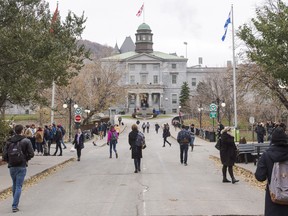Central bank believes slack in economy will give it room to cut rates, but fewer students could tighten labour market and scuttle that
Article content
Immigration Minister Marc Miller’s announcement early Monday morning that he was capping foreign student numbers would have almost certainly come to the immediate attention of the Bank of Canada’s governing council, which was meeting at the central bank’s headquarters in downtown Ottawa to deliberate on its Jan. 24 policy decision.
The cap was new and material information that came too late to be seriously incorporated into their analysis. There’s no mention of it in the policy statement, the opening remarks by governor Tiff Macklem at his press conference or in the quarterly projection report that was also released on Wednesday.
Advertisement 2
Article content
Article content
When asked about it at the press conference, senior deputy governor Carolyn Rogers cited the links between immigration and housing inflation but had nothing to say about the underlying impact of slowing population growth on economic activity. Yet, it will almost certainly be consequential, even as the outcome is not clear cut.
As widely expected, the governing council decided ultimately to hold its policy rate unchanged this week. But they indicated that interest rate cuts will be coming as long as inflation pressures continue to abate.
And they believe inflation will continue to abate because the economy is entering a period of economic slack that will cool demand.
Intuitively, it makes sense that the less international migration there is, the less demand there will be for goods and services, which should continue to create slack in the economy. In theory, this should give the Bank of Canada more scope to cut rates. But that’s not the whole story.
Student caps will also be limiting the influx of new workers into an economy that is actually struggling to absorb them. We’ve already seen a relatively significant increase in the unemployment rate that is disproportionately impacting new entrants to the labour force.
Advertisement 3
Article content
So, fewer available new workers could actually mean less slack in the economy and keep the labour market tighter than it would have been otherwise. Here are some rough estimates. The student permit cap should at very minimum stabilize (if not shrink) the number of people living in the country under the student permit system, currently at about one million.
Assuming the federal government still brings in half a million permanent residents as targeted and keeps levels for other types of temporary migrants stable, population growth should slow to somewhere around 1.3 per cent annually over the next two years. This is within historical averages but marks a sharp slowdown from the off-the-charts three-per-cent pace we saw for population and the labour force in 2023. What’s the central bank’s projection for population growth? According to its monetary policy report, it’s “just below” two per cent annually in 2024 and 2025.
Recommended from Editorial
Remember, the central bank expects inflation to abate in part because it believes the working-age population will continue growing at elevated levels into a weakening economy, creating excess supply that will allow for rate cuts.
No doubt, Bank of Canada officials were more confident about that assumption last week than they probably are now.
Theo Argitis is managing director at Compass Rose Group.
Bookmark our website and support our journalism: Don’t miss the business news you need to know — add financialpost.com to your bookmarks and sign up for our newsletters here.
Article content
How the foreign student cap could hinder Bank of Canada rate cuts
2024-01-26 12:00:41





